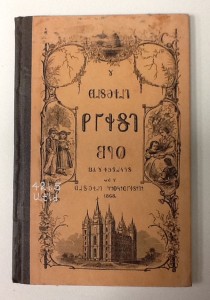By: Ashley Bond, SLIS graduate student
In 1868, the Deseret First Book was one of two elementary readers printed in the Deseret alphabet of the Church of Jesus Christ of Latter-day Saints. The University of Deseret, now the University of Utah, utilized the texts to help the community learn this new alphabet. At the beginning of the book is a translation key, followed by reading and numerical lessons. The book also contains many illustrations, with the most intricately drawn images on the front cover and title page. While these cover drawings serve an aesthetic function in framing the title of the work, they also contain imagery significant to the Mormon Church.
The building pictured at bottom center of the cover depicts the Latter-day Saints’ Salt Lake Temple located in downtown Salt Lake City, Utah. Historically, it is said that Latter-day Saints President Brigham Young designated the site for a future temple within days of his arrival in the Salt Lake Valley. In July of 1847, while he and a few others were walking through the area now known as Temple Square, Young stopped between two forks in City Creek and struck his cane on the ground. Wilford Woodruff placed a stake in that specific spot, marking where the center of the future temple would be. With the help of architect Truman O. Angell and draftsman William Ward, Young designed a temple with six towers: three on the east representing the President and his two counselors and three towers on the west representing the Presiding Bishop and his two counselors. The building was constructed with granite in addition to symbolically placed ornamental stones throughout the structure. The Salt Lake Temple was completed and dedicated on April 6, 1893, exactly forty years after the day the cornerstones were laid.
A drawing of a beehive also decorates the top center of the Deseret First Book’s cover and title page. Deseret is a term that means “honeybee” in the Book of Mormon. Honeybee and beehive imagery are significant in Mormon culture and frequently seen atop buildings in Salt Lake City, on park benches, license plates, stock certificates, and even etched as honeycomb patterns on the sidewalks in downtown Salt Lake City. While there are various beliefs about the origin of the beehive symbol in Utah, scholars agree that honeybees represent cooperation and industry to the state. In the Book of Mormon, Jaredite peoples brought swarms of honeybees with them to their new land. This is significant because of the ancient Egyptian belief that swarms of bees were a sacred sign. In the early days of Mormon settlements in the west, a committee led by Brigham Young proposed the creation of a State of Deseret to the federal government with the beehive as the official state symbol to remind residents of the Jaredite civilization. The proposal was rejected, however, and President of the United States Millard Fillmore created the territory of Utah instead on September 9, 1850.
Although Young ordered the unofficial State of Deseret to dissolve after this, his desire for the state’s acceptance remained. In 1854, he had the Beehive House built as his official residence as governor of Utah. This house, with interior beehive decorations and a large hive on the roof, stood both as a symbol of disapproval in the federal government’s interference in creating the State of Deseret as well as a hope for it to exist in the future. Residents of Salt Lake City began to embrace the beehive, and with Young’s direct influence in city organizations, the symbol become even more prominent in the city. With the final federal rejection of the State of Deseret in 1872, however, the link between the beehive and the term deseret dissolved, with only the beehive symbolism remaining. On April 3, 1896, officials adopted the Great Seal of the State of Utah, which can be seen on the state flag with a beehive next to the word “industry.” The beehive also became the official state emblem of Utah on March 4, 1959.
While the term deseret is typically no longer linked to Utah’s beehive imagery, some businesses and organizations connected to the Church still closely associate the two. Ultimately, Brigham Young desired a Book of Mormon symbol that would stand the test of time, and the beehive’s prevalence throughout Salt Lake City today is evidence that he succeeded in his choice.

